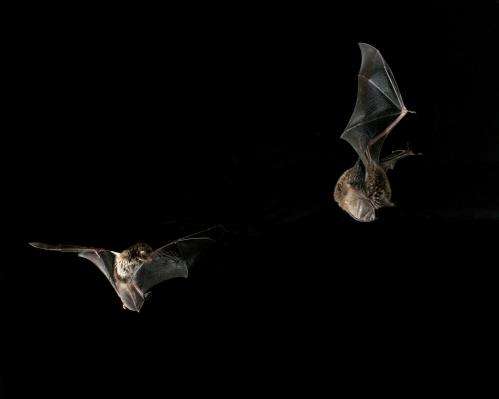Bats must carefully balance physiological mechanisms in response to variation in factors such as ambient temperature, availability of food, and mating requirements. Myotis daubentonii funnels a prey insect with the aid of the wing into the tail pouch to eat it during flight. Credit: Marko Koenig /Mammalian Ecology Group, JLU Giessen
A forthcoming article in Physiological and Biochemical Zoology reveals shifts in the mechanisms bats use to regulate metabolism throughout their seasonal activity period.
As small and active flying mammals, bats have very high mass-specific energy requirements and as such continually adjust their rates of activity and metabolism in response to ambient temperature and other seasonal variation. In particular, during the autumn mating season, male bats must carefully balance time spent foraging (to gain enough fat to last the winter hibernation) with time spent finding a mate. Because both activities require significant effort, how do male bats do it? In an upcoming issue of Physiological and Biochemical Zoology, Nina Becker and colleagues reveal that the answer lies in the bats' resting metabolic rate.
In their study, the group monitored the thermoregulation, energy intake, activity, and metabolism of free-ranging Daubenton's bats Myotis daubentonii during this insectivorous species' main activity period of the year (mid-April to mid-October).
Becker et al. found that during spring, when ambient temperatures are low, prey is scarce, and the male bats are reproductively inactive, M. daubentonii used daily torpor (decreased body temperature) to balance their energy budgets.
In summer, when temperatures and abundance of insects increase, bats shift their behavior away from long and frequent bouts of torpor and toward more intake of food. In males it is predicted that this increase in feeding is done in anticipation of the impending mating season, when energy requirements are high but low insect abundance and significant time spent finding a mate (and therefore not foraging) mean that food intake will be at its lowest during the animals' entire period of activity.
In autumn, for male M. daubentonii to accommodate the high energy demands of reproduction and low energy intake and also sufficiently prepare for hibernation, Becker and colleagues report that the bats do not increase torpor, as they do in spring, but instead employ metabolic compensation to reduce resting metabolic rate. In this way, energy expenditures are reduced and thus the low amount of food the bats consume is enough for them to survive the winter. The exact mechanism allowing this reduction in resting metabolic rate is still in question, but the authors speculate it is likely due to a decrease in activity of either the digestive system or the brain.
More information: Becker, Nina I., Marco Tschapka, Elisabeth K. V. Kalko, and Jorge A. Encarnação. "Balancing the Energy Budget in Free-Ranging Male Myotis daubentonii Bats." Physiological and Biochemical Zoology 86:3 (May/June 2013).
Journal information: Physiological and Biochemical Zoology
Provided by University of Chicago





















